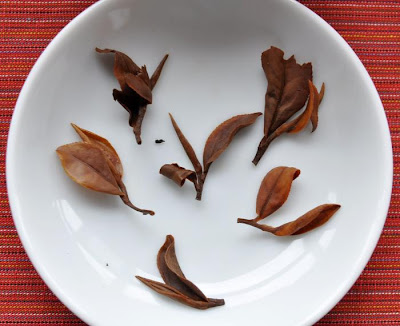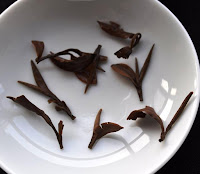 |
| Qingbai mini cup, mini gaiwan and classic cup |
Thanks to credit cards, it's easy to get carried away and spend more than you should or can afford. And since you need a credit card to debit your Paypal account to pay for your Internet orders, the temptation is there. Nevertheless, I sincerely hope that you have already saved enough to make your tea order, or that it's within your normal budget. The pleasure of enjoying tea shouldn't be clouded by the worry of reimbursement. Life and work is about giving and taking. We earn money by giving our time and effort to help others ; and with this money we can purchase what we need and desire. To have a mind at ease that is receptive to the delicate pleasures of tea, we need to lead a well balanced life, including our finances.
In the Cha Jing, Lu Yu writes that bad tea can be harmful to the body. Therefore, I'm not going to recommend selecting low quality leaves to reduce your tea expenses. A better strategy is to lower your consumption with smaller tea ware.
I've noticed that my qingbai mini gaiwan is very popular with students! Its volume is 85 ml to the top and 60 ml in normal use. Its tea can fit in just 1 singing cup!
 |
| A singing cup, classic cup, mini cup, 2 old mini cups and 1 old mini qinghua cup |
And I'm introducing a new qingbai mini cup with a volume of 33 ml to the top and 20 ml in normal use. (Like this 3 people could share 1 mini gaiwan!) Weight: 20 grams.
For comparison, I've added 2 old mini qingbai and 1 mini qinghua cup.You can see that ancient Chinese used this strategy of downsizing! They also understood the law of diminishing returns for food pleasures: the quality of the first cups matters more the quantity you drink.
 |
| 2011 spring Alishan Oolong |
On this picture, you can see all the leaves and dust that I had left in a foil from last year's top Ali Shan spring Oolong. This Oolong wasn't roasted, but dried well nevertheless. It has kept its freshness and still makes a great brew:

Don't throw away unfinished bags of good tea! And if you still have unroasted Oolongs or Baozhongs (or green tea), try to finish them before ordering more.
One mini gaiwan can surely fill many cups:
I also brewed the rest of my 2011 spring Shan Lin Shi Oolong recently and found that the aging had had a stronger effect on the freshness of that tea. It felt more oxidized, less 'green'. The taste had a slight fruity sourness and more warmth. As temperatures have dropped here, I found this change of character quite soothing and relaxing. What's important is that the tea was still powerful and sweet.
A last tip is to brew until the leaves have been fully exhausted! I'm still surprised, from time to time, by how good that very last brew can taste.
Neutral, small and thin qingbai porcelain makes tea a luxury we can all enjoy and afford!
Note: The big qingbai ware you see in the last picture is a rather flat bowl by David Louveau (and I'm using it here for waste water).


























































